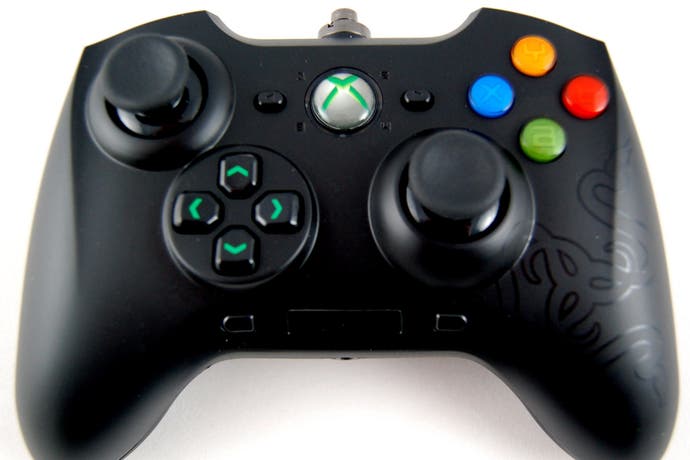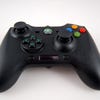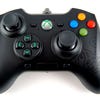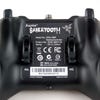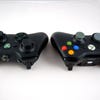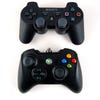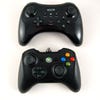Razer Sabertooth review
Can the case be made for a £70 joypad?
Let's face facts - you've got to come up with something phenomenally good to justify charging £70 for an aftermarket Xbox 360 joypad when the standard controller supplied out of the box isn't bad at all, let down only by its miserable digital d-pad. Razer's proposition with its new Sabertooth controller is fairly straightforward - it essentially copies the basic design of the standard Microsoft pad, ramps up the build quality and materials in all areas, and introduces customisable functions designed to appeal to the ultra-competitive first-person shooter crowd.
Opening up the package offers up some pleasant surprises. The pad is found within a robust fabric container, protected from harsh outside forces by a flush foam insert with netted pockets for the accessories. Prising the pad free from its deluxe receptacle, we find the controller itself to be a class apart from the standard 360 effort. A rubberised skin offers a reassuring non-slip surface, the high-quality impact of the materials only slightly diminished by the rather cheap-looking embossed snake motifs on the bottom right. On the rear of the pad we find a din-style interface into which a 3m braided cable is inserted, the other end finding a home on the USB port of the console.
The joypad has just about the right level of heft and the control elements themselves feel outstanding - the analogue sticks have a good level of travel and remain glued to your thumbs via a non-slip, rubberised finish (optional day-glo coverings are also provided for an even higher level of grip). The face buttons and the two bumpers are deliberately shallow, and micro-switched to boot - giving a feeling of immense confidence in the controls compared to the equivalents on the standard controller, which now suddenly feel somewhat sponge-like and sub-optimal in comparison.
"First impressions are positive - overall presentation is excellent and the controller feels a class apart from the standard Microsoft pad."
Perhaps the most notable improvement in the standard layout comes from the digital d-pad. On Microsoft's standard offering, all four directions are embossed onto a single plastic dial, offset significantly from the controller's mainboard, resulting in a lacklustre, muggy, unresponsive experience that ruins almost all one-on-one fighting games, not to mention games designed with digital controls in mind such as the beautiful Pac-Man: Championship Edition. In contrast, the micro-switched equivalents on the Sabertooth are an absolute revelation, offering much-needed precision input on this overlooked area of the original design.
So far, so good - what we have here is a controller built with premium materials and offering resounding improvements over the standard pad, it's a product that significantly improves the fundamental interface between player and game, which is no mean feat. However, the Sabertooth's major draw is its customisation options - these range from adjusting the sensitivity of the analogue sticks to the inclusion of six additional buttons - two more on the top of the pad and four on the rear (consisting of two 'rocker'-like arrangements that can be removed if needs be via a supplied screwdriver).
These buttons are remapped to mimic any of the face buttons, the principle advantage here being that players can access that functionality without having to remove their thumbs from the right analogue stick. Clearly designed with shooters in mind, in theory this allows you to continue to adjust your view while at the same time activating features such as jumping, reloading or swapping weapons. It's a small, almost insignificant advantage for mortal players but for those operating on the bleeding edge of pro gameplay, it may well be worth the price of admission.
"In terms of finish and functionality, the Sabertooth effortlessly surpasses the standard pads offered for all the current-gen consoles."
Programming the additional buttons is achieved via a special button located (perhaps a touch unhelpfully, should your thumb slip) directly underneath the right analogue stick, while another button to the left allows you to switch between two different profiles, allowing you to tailor settings to individual games, swapping between them with ease. Helping you to set everything up is a small, green, high-quality OLED screen built into the bottom of the device, which guides you through the programming procedure and simply displays the Razer logo during actual gameplay.
The final flourish to the overall design comes from LED backlighting to the face-buttons - fundamentally useless really, bearing in mind how well we all know the overall layout of the Xbox 360 pad, and the fact that gamers typically look at the screen rather than the controller - but it lends an additional sense of quality to what is already an excellent product.
Just about the only negative element of the feature-set is the omission of wireless support here, which is a shame - in theory you will save a few milliseconds of response through a cabled connection (though wireless latency on the 360 pad is negligible really) - but its omission is more a matter of general inconvenience than anything else. However, the USB-only situation is something of a blessing in disguise in that it allows the Sabertooth to connect up easily to both PC and Xbox 360 - not to mention a bunch of compatible devices like Android tablets, for example.
"The lack of wireless support is the only disappointing element in the pad's feature-set, though the USB connection makes it perfectly viable for PC gameplay too."
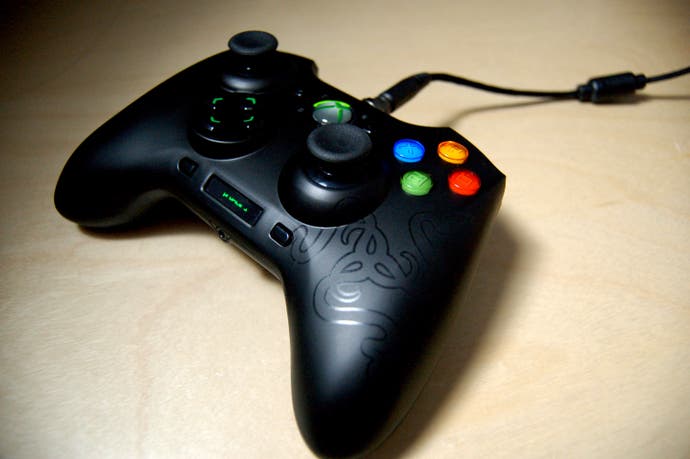
Razer Sabertooth - the Digital Foundry verdict
What we like most about the Sabertooth is the fact that it isn't trying to re-invent the wheel - there are no clumsy attempts to fix anything that isn't broken. As you can see from the controller comparison photo gallery, fundamentally the size and shape of the Sabertooth represents a very close match to the standard Microsoft pad, ensuring that you can move from one to the other and feel almost completely at home right from the off. From there, the benefits of the pad immediately stand out - the analogue sticks feel palpably better, the d-pad addresses the horrendous performance of the standard controller, while the micro-switched buttons with their short travel are an immense improvement. Few of us can argue that the 360 pad isn't a decent controller for the vast majority of games, but the Sabertooth demonstrates fairly conclusively that there is scope for significant improvement and that deluxe materials and intelligent design can make a big difference.
Ironically, it's the additional buttons - specifically the rear-mounted rocker-type efforts - that don't have quite the same level of quality as the rest of the controls, but regardless, they work well enough. The only problem is that the core proposition behind this product - accessing face-button functionality while still using the right analogue stick - only really appeals to the most hardcore of gamers, and mostly just to those playing first-person shooters.
And then there's the price - a staggering £70. There's room in almost any market for a high-quality, premium product and when it comes down to something as fundamentally important as the hardware that connects player and console, clearly a positive case can be made for the Sabertooth's finish and functionality. However, a price-point equivalent to two full-price games is still a huge ask - and we can't help but feel that it's pitched way too high to enjoy any kind of mainstream success. The chances are the Razer knows that too, that this is a deliberately niche offering, but we can't help but feel that there's a major opportunity missed here.
In the past, we've only ever considered third party controllers for certain game types where the standard pad is simply the wrong fit - one-on-one fighting games, primarily. But if we've learned anything from producing this review, it's that the market is crying out for a third party pad that improves on the fundamentals of the Microsoft controller using much higher-spec components. In theory, that's the market sector addressed by the Sabertooth's predecessor, the Razer Onza - but the fact is that its successor improves on it in almost every way, especially in terms of all-important build quality. A few days of hands-on time with the Sabertooth demonstrates that there's an outstanding, break-out product lurking behind the niche customisable features. Strip this pad down to its fundamentals, slash the price and we'd be first in line to buy it.
